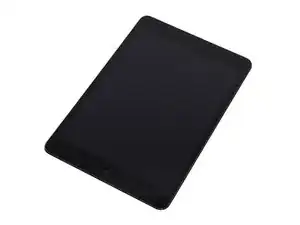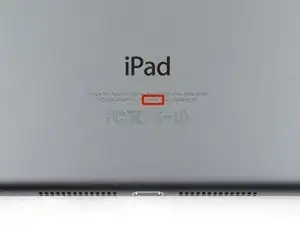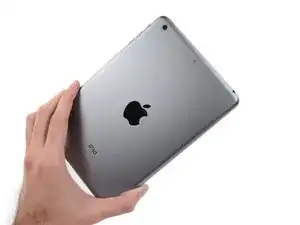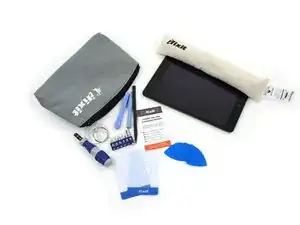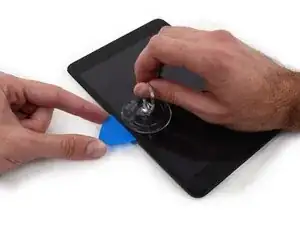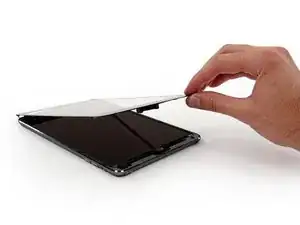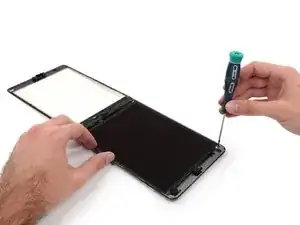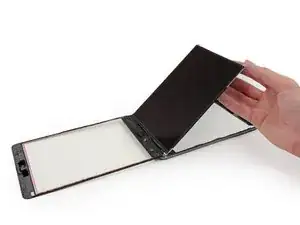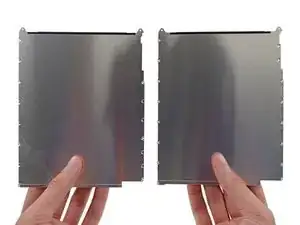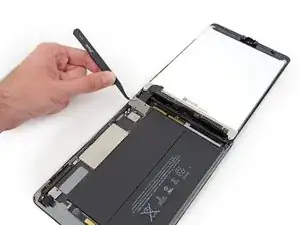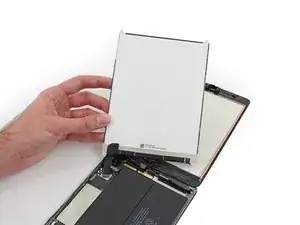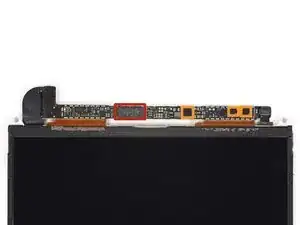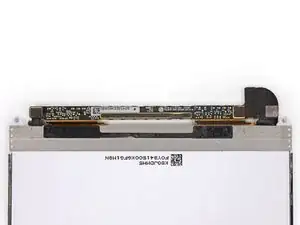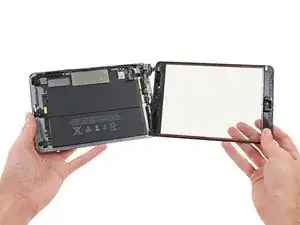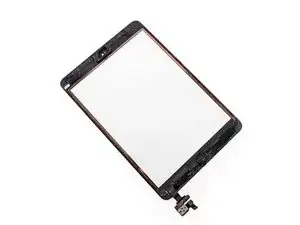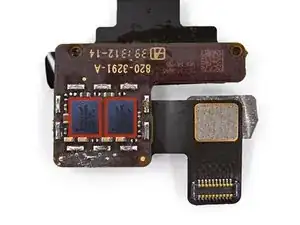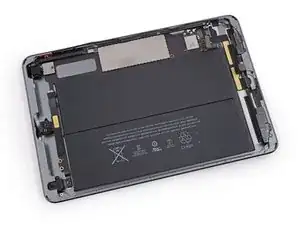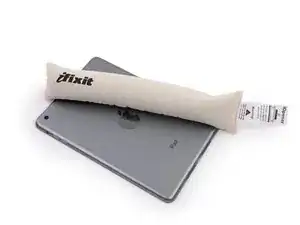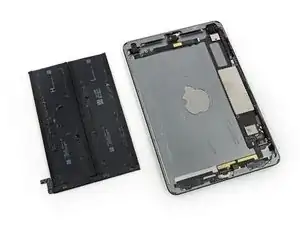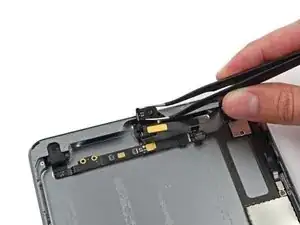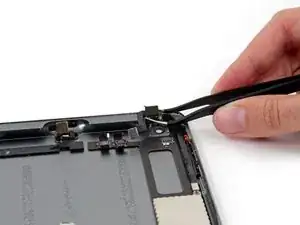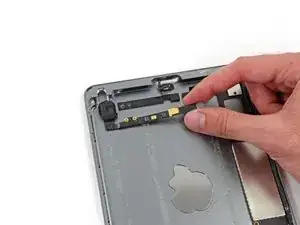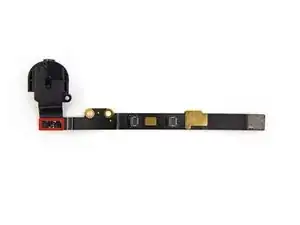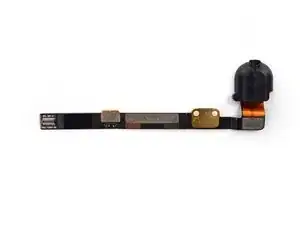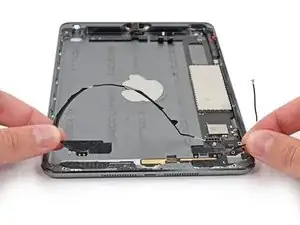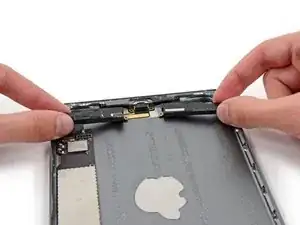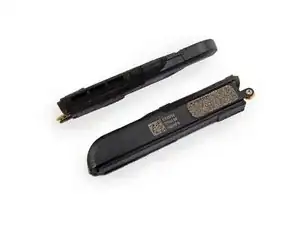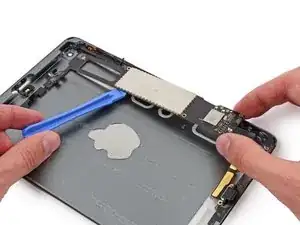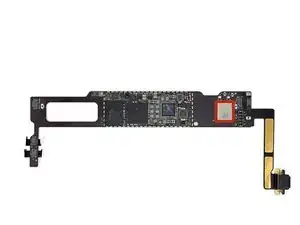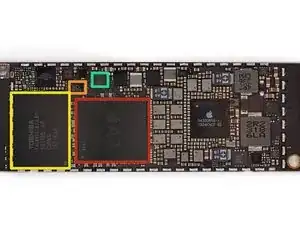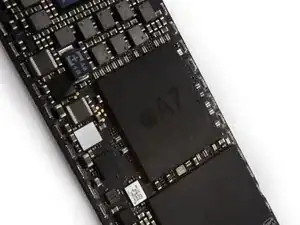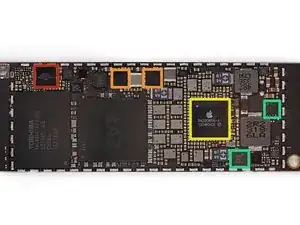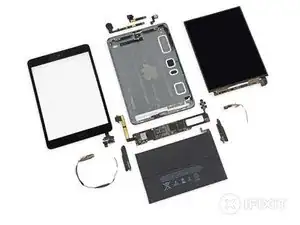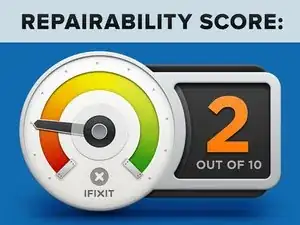Einleitung
Lots of new tech ensures the iPad Mini Retina Display is a worthy successor to both the iPad Air and last year’s iPad Mini—but will it carry the familial low repairability? Follow along as we reveal the inner workings of this compact new Retina device.
Want to stay up to speed on teardowns? Find out what's to come via Instagram, Facebook, and Twitter!
Werkzeuge
-
-
While its big brother slimmed down, the iPad Mini put on a thin layer of winter fat to make room for its impressive new tech:
-
7.9-inch, in-plane switching LCD with 2048 x 1536 resolution at 326 ppi
-
Dual-core A7 CPU with 64-bit architecture and 1 GB RAM
-
M7 motion-tracking coprocessor
-
5-megapixel rear iSight camera with 1080p video; 1.2-megapixel 720p front-facing camera
-
802.11n dual-channel MIMO Wi-Fi
-
16, 32, 64, or 128 GB storage
-
-
-
We like to start things off with a model number. Today's contestant: A1489.
-
Apple's high-end handhelds come in a fancy new color option, "Space Gray."
-
-
-
Our Opening Kit ought to offer oodles of optimism to fearless fixers; iOpeners impart inroads into iPads. (Who doesn't love a little alliteration?)
-
We've never opened an iPad Mini with Retina Display before, but we're confident this kit is up to the challenge.
-
In this teardown staredown, the Mini blinks first: after offering up the usual gluey resistance, it succumbs and releases its front panel.
-
The ridiculous amount of glue holding iPads together is no longer any surprise—but that doesn't make it okay. Glue inhibits repair, and that is bad. Really bad.
-
-
-
We begin removing the titular update to this Mini: the Retina Display.
-
All the pixels in the world couldn't keep our Pro Tech Screwdriver Set at bay.
-
Powering all those extra pixels comes at the price of 0.3 mm of added thickness in comparison to last year's Mini.
-
-
-
It looks like Apple has been doing some pruning. The 16 screws in the previous iPad Mini's LCD shield plate must have been deemed excessive; we're now down to seven screws.
-
"Waste not, want not." The same shields appear to be popped into the new Minis—they're just missing some (now obsolete) screw holes.
-
These LCD and digitizer cable connectors aren't fooling anybody—tweeze away that bracket and pop off the connectors, and the LCD is home free.
-
-
-
Rumors abounded about problems sourcing the pixel-dense Retina display, slowing iPad Mini Retina production. That makes us extra-curious to get a look inside ours.
-
Our little Retina has an LG display, powered by a Parade DP675 LCD driver, similar to the DP655 found in the iPad Air.
-
Also present at the party, a TI TPS65143A and a pair of TI TPS65195, all likely LCD power supply ICs.
-
While "mini" tends to denote added cuteness with compromised functionality, this Mini packs a resolution of 2048 x 1536—just like the Air.
-
-
-
We've reached the source of power. Here are the runes on the black box:
-
3.75 V, 24.3 Whr, 6471 mAh—a huge bump over the 16.3 Whr battery seen in the previous Mini. It seems we've found the source of the Retina's thicker skin.
-
In spite of those specs, Apple still pegs the battery life at 10 hours. We suspect the extra juice is being funneled into the swanky new display.
-
To fight the dark magics (well, adhesives) binding this battery, we call upon the awesome powers of the iOpener once more.
-
-
-
If at first you don't succeed, (heat and) pry, pry again.
-
The new dual-cell battery design means more edges with more glue, and requires more muscle to remove.
-
After quite a bit of said prying, we flip the grilled battery out of the case like a shrimp on the barbie.
-
-
-
While the new battery cools its jets, we work our way down the hit list of remaining components.
-
First to go is the front-facing camera. This little bit of face-to-FaceTime is still rated at 1.2 MP, 720p, and is marked 821-1752-A.
-
On the flip side, the usual 5 MP rear-facing camera.
-
-
-
Jack be nimble, Jack be slick—remove that headphone jack right quick!
-
The tiny ICs sprinkled around the headphone jack are the same ones found in the Air. They're likely audio amplifiers, but they aren't very chatty about their origins.
-
-
-
Following the Formicidaean design choices of the Air, this Mini maxes out on efficiency with dual antennas.
-
Out too go the dual voice boxes.
-
-
-
An exploratory plastic opening tool reveals the only thing stuck under there are bad memories from last time.
-
That's right: The only adhesive under this logic board is a bit under the panhandle full of connectors, and a solid swath under the Lightning connector cable.
-
Instead of glue, the logic board is seated over a couple of screwposts for security—a mini win for repairability!
-
-
-
Holy holes, Batman! What's this? Wi-Fi-only Minis of yesteryear featured a blank expanse at the end of the logic board—just a flat space where the cellular chips would be in a CDMA/GSM version. This Retina Mini's board has a nifty cutout instead.
-
Also making an appearance, the USI 339S0213 Wi-Fi Module, as seen in the iPad Air.
-
-
-
Who's got the dip? We've got chips! Tasty, tasty, silicon chips (Disclaimer—Please do not consume microchips):
-
Apple A7 APL0698 SoC—This is the same part number as seen on the iPhone 5s, as opposed to the iPad Air's hotrod 1.4 GHz version
-
Within the A7 package is Elpida F8164A1PD 1 GB LPDDR3 DRAM
-
NXP LPC18A1 (Apple M7 Motion Co-Processor)
-
Toshiba THGBX2G7B2JLA01 16 GB NAND flash
-
B334 STMicro MEMS accelerometer/gyroscope, the same as seen in the iPad Air
-
-
-
More chips, because we love chips.
-
Apple 338S1213 Cirrus Audio Codec
-
Apple 338S1199—likely a pair of audio amplifiers, similar to the Apple 338S1077 found in the previous iPad mini
-
Apple 343S0656-A1
-
Fairchild Semiconductor FDMC6676BZ and FDCM6683 MOSFETs
-
-
-
iPad Mini Retina Display Repairability: 2 out of 10 (10 is easiest to repair).
-
The LCD and glass are not fused together and can be replaced independently.
-
The battery is not soldered to the logic board or other components.
-
Teeny-tiny screws can be easily misplaced if you're not careful. Don't sneeze too hard while taking them off.
-
Copious amounts of adhesive hold many components in place—front glass, battery, front camera, back camera, ribbon cables—making repair extremely difficult.
-
The Lightning connector is soldered to the logic board, so don't bend its pins.
-
Hidden screws mean you'll need to be very diligent when trying to remove internal components.
-
18 Kommentare
Screw your stupid scoring system.
The less the score, the more performance to weight ratio and the more perfectly crafted and engineered a device is.
daviet86 -
iPads are a pain in the !@# to repair, especially the glued up part and the open-up-and-wreck-up foam gasket around the LCD. I would have given that only 2 scores too
But the Ifixit guys are a bit old schooled. They still believe the pentalobe screws are bad for repairs. Now the screwdrivers are $1 each. So much for 'proprietary' screws. And I actually support the trend of bonding the glass to the LCD. This actually toughens up the display module and eliminates dust under the glass panel. Which is a major headache when you open up the device to repair it
Tom Chai -
Keep in mind this is purely a REPAIRABILITY score, not a review of the engineering quality, usability, or a reflection on its performance-to-weight ratio. I think the Retina iPad Mini is a terrific product and hands down is better in all other categories (build quality, performance/weight, software ecosystem, battery life, etc.) when compared to it's competitors. I wouldn't let a low iFixIt repairability score deter me from purchasing the product, but would certainly, based on this teardown, think twice about attempting a repair on it myself. In fact, after reading this (and other iFixIt Apple product teardowns), I would consider spending a little extra on the AppleCare warranty to avoid making a complete mess of a well constructed (but hard to repair) device.
Instead of all that glue, Apple should look into using high-quality Velcro. It'd bind in place as well as glue and be easier to remove than glue or screws.
@daviet86 I for one appreciate the scoring system because it creates a scale of relativity in order to compare the difficulty level between two disparate systems. I prefer to know what I'm getting myself into before getting into it. I also wouldn't agree that inordinate amounts of glue increases performance. If you don't like the system don't read it....simple enough.
scott -

